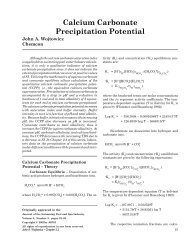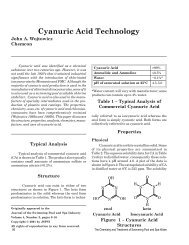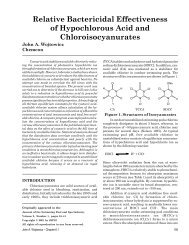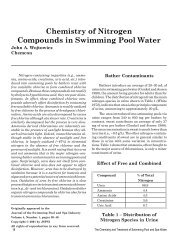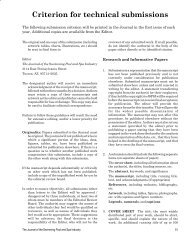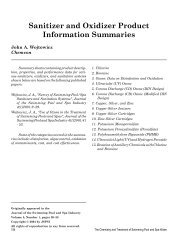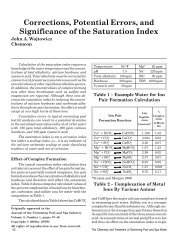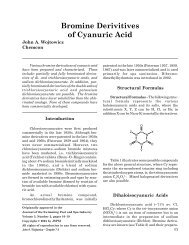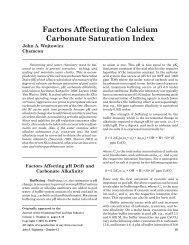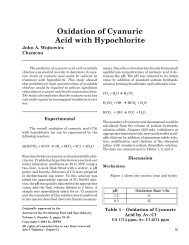Swimming Pool and Spa Water Chemical Adjustments - jspsi
Swimming Pool and Spa Water Chemical Adjustments - jspsi
Swimming Pool and Spa Water Chemical Adjustments - jspsi
You also want an ePaper? Increase the reach of your titles
YUMPU automatically turns print PDFs into web optimized ePapers that Google loves.
<strong>Swimming</strong> <strong>Pool</strong> <strong>and</strong> <strong>Spa</strong> <strong>Water</strong><br />
pH Adjustment via Test Kit<br />
Analysis<br />
Acid Dem<strong>and</strong> – This test determines the<br />
amount of acid required to reduce the pH of<br />
swimming pool or spa water when it has exceeded<br />
the recommended range of 7.2 to 7.8 (see Table 1).<br />
The acid dem<strong>and</strong> test involves titration of a pool<br />
or spa water sample with acid to a desired pH;<br />
e.g., using a Taylor test kit. A st<strong>and</strong>ard acid<br />
solution (dilute sulfuric acid) is added dropwise to<br />
a known volume (44 mL) of pool or spa water<br />
containing a pH indicator (phenol red) until the<br />
desired pH is obtained as determined by the color<br />
change of the indicator. Tables are available to<br />
convert the number of drops of acid solution to<br />
volume of pool acid (muriatic acid, i.e., hydrochloric<br />
acid, HCl) to decrease the pH to the desired<br />
level (Taylor 2002). Based on these Tables, the<br />
quantity of muriatic acid (31.45% HCl) required<br />
can also be calculated using the following formula:<br />
V MA (fl. oz ) = 9.165•10 – 4 •N•V<br />
where: V MA (fl. oz ) equals the volume of muriatic<br />
acid, N equals the number of drops of acid dem<strong>and</strong><br />
reagent, <strong>and</strong> V equals the pool or spa<br />
volume (gals).<br />
Dry acid, i.e., sodium bisulfate, can also be<br />
used to lower pH. Tables are available for determining<br />
the quantity of bisulfate to add based on<br />
the number of drops of reagent <strong>and</strong> pool or spa<br />
volume. The quantity of sodium bisulfate also can<br />
be calculated using the following formula, which<br />
is based on these Tables:<br />
W BS (oz) = 1.148•10 – 3 •N•V/p<br />
where: W BS equals the weight of sodium bisulfate,<br />
N equals the number of drops of test kit acid<br />
dem<strong>and</strong> reagent, V equals the volume of pool or<br />
spa, <strong>and</strong> p equals the degree of purity of sodium<br />
bisulfate.<br />
Base Dem<strong>and</strong> – This test determines the<br />
amount of sodium carbonate (soda ash) required<br />
to increase the pH of pool or spa water when the<br />
pH has dropped below the recommended range of<br />
7.2 to 7.8, e.g., due to a high dose of gaseous<br />
chlorine or high usage of chloroisocyanurates.<br />
The base dem<strong>and</strong> test involves titration of a pool<br />
or spa water sample with base to a desired pH;<br />
e.g., using a Taylor test kit. A st<strong>and</strong>ard base<br />
solution (dilute sodium hydroxide) is added<br />
dropwise to a known volume (44 mL) of pool or spa<br />
water containing a pH indicator (phenol red)<br />
until the desired pH is obtained as determined by<br />
the color change of the indicator. Tables are<br />
available to convert the number of drops of base<br />
solution to weight of soda ash (sodium carbonate)<br />
to increase the pH to the desired level (Taylor<br />
2002). The quantity of 100% sodium carbonate<br />
required can also be calculated using the following<br />
formula:<br />
W SC (oz) = 5.12•10 – 4 •N•V<br />
where: W SC equals the weight of sodium carbonate,<br />
N equals the number of drops of base dem<strong>and</strong><br />
reagent, <strong>and</strong> V equals the volume of pool or spa<br />
water (gals).<br />
Calculation of <strong>Swimming</strong> <strong>Pool</strong><br />
<strong>and</strong> <strong>Spa</strong> <strong>Water</strong> <strong>Chemical</strong><br />
Parameters <strong>and</strong> <strong>Adjustments</strong><br />
Computer Assisted Calculations<br />
The basic data <strong>and</strong> equations for calculating<br />
certain changes in water chemistry have been<br />
published in previous issues of the journal (e.g.,<br />
see Wojtowicz 1995b, 1995c, 2001, <strong>and</strong> 2002). The<br />
changes include: acid <strong>and</strong> base requirements for<br />
adjusting pH <strong>and</strong> pH changes on addition of<br />
chlorine, sodium bicarbonate, <strong>and</strong> cyanuric acid.<br />
The input data for the calculations are: pool or spa<br />
volume, water temperature, total dissolved solids,<br />
initial <strong>and</strong> final pH, total alkalinity, cyanuric<br />
acid, boron, <strong>and</strong> av. Cl. In the case of carbon<br />
dioxide loss calculations, additional data are necessary<br />
such as pool or spa surface to volume ratio,<br />
pumping rate, <strong>and</strong> pump duty cycle.<br />
Variables, Constants, <strong>and</strong> Conversion<br />
Factors<br />
Various conversion factors <strong>and</strong> variable sym-<br />
184 The Chemistry <strong>and</strong> Treatment of <strong>Swimming</strong> <strong>Pool</strong> <strong>and</strong> <strong>Spa</strong> <strong>Water</strong>



